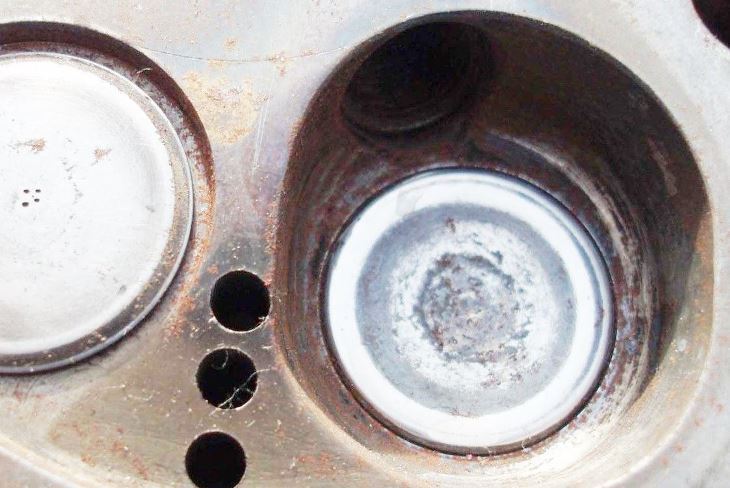Can our esteemed engine experts pass any clues?

Mini mystery cylinder head. (Leyland/BMC)
#1

Posted 05 August 2014 - 08:33
Can our esteemed engine experts pass any clues?
Advertisement
#2

Posted 05 August 2014 - 09:04
Best guess is a BMC light tractor cylinder head. Since the engine could hardly move the tractor, it is unlikely to move a mini much.
Edited by JtP2, 05 August 2014 - 09:05.
#3

Posted 05 August 2014 - 17:02
If I recall correctly the BMC mini-tractors (nothing whatsoever to do with the mini car) used a 1.5 litre (1498cc) diesel as fitted to some '60's J4 and, I think, J2 vans in addition to some Farina-bodied Oxford/Cambridge cars for taxi use. All quite gutless. This head doesn't look like a diesel head. But I do not recall seeing one off a 1.5 motor. I do recall seeing the result of a diesel J4 that had been fed diesel then hoofed up the road though...... Not much left to work with.
Did I really write "fed diesel"? I meant Shell's best 5 star (remember that?). Old age I guess......
Edited by Dipster, 06 August 2014 - 09:35.
#5

Posted 06 August 2014 - 02:24
Love the speed holes in cylinder two or whatever the British numbering convention is, possibly involving oaken barrels or royal anatomy.
#6

Posted 06 August 2014 - 06:16
Cylinder 3. 3rd from the thermostat housing/radiator/water pump. What's a speed hole BTW?
#7

Posted 06 August 2014 - 06:43
The BMC Mini tractor used an A series engine in petrol and diesel. I know of someone that fitted a diesel engine to his Morris Minor van, it was gutless so he added a turbo. It is still gutless but it sounds fast.
#8

Posted 06 August 2014 - 14:54
The speed holes were apparently something to do with testing as it is a prototype combustion chamber. I don't know if it was pressure or temperature probes.
The BMC Mini tractor used an A series engine in petrol and diesel. I know of someone that fitted a diesel engine to his Morris Minor van, it was gutless so he added a turbo. It is still gutless but it sounds fast.
I think the engine was based on the B Series. I do not think the factory got near 1500cc with the A Series.
#9

Posted 06 August 2014 - 15:03
#10

Posted 06 August 2014 - 20:03
The Mini Tractor motor was 950cc in both diesel and petrol versions. It was an A series engine.I think the engine was based on the B Series. I do not think the factory got near 1500cc with the A Series.
#11

Posted 07 August 2014 - 07:53
Well there you go, my memory is failing me. I really did not recall them being so tiny.
#12

Posted 07 August 2014 - 09:46
Simpsons reference-- http://cheezburger.com/5749166592
Thanks Desmo. ![]() I should have Googled it shouldn't I?
I should have Googled it shouldn't I?
#13

Posted 07 August 2014 - 12:37
The later Mini Tractors had engines based on the B Series.
#14

Posted 08 August 2014 - 07:20
They would be the ones that weren't Mini Tractors.The later Mini Tractors had engines based on the B Series.
#15

Posted 08 August 2014 - 07:41
#16

Posted 09 August 2014 - 04:26
Certainly not "Maxi Tractors".
#17

Posted 09 August 2014 - 05:54
They would be the ones that weren't Mini Tractors.
Major Tractors?
#18

Posted 10 August 2014 - 20:11
They would be the ones that weren't Mini Tractors.
Landcrabs
#19

Posted 13 August 2014 - 02:14
Its definitely a diesel. The recess where the inlet valve is (i think its the inlet as the pre-chamber is where the combustion starts) is the pre-chamber. There's no way you could fit a spark plug into the 4 holes in the head that look like the plug holes as the valve would hit it.
Advertisement
#20

Posted 13 August 2014 - 02:27
#21

Posted 13 August 2014 - 03:23
It isn't a diesel. The spark plug is biased towards the exhaust valve.
Or it could be the inlet valve and not a spark plug hole, but the injector hole. The electrode end of a spark plug always protrudes into the combustion chamber, on this head it would interfere with the valve.
Why are you so sure its the exhaust valve?
#22

Posted 13 August 2014 - 04:42
The spark plug holes are parallel on a normal A-Series engine.
I think it has to be a diesel head - clearly it has a very high CR but the valves are too small for it to be some type of racing engine.
#24

Posted 13 August 2014 - 10:32
I was hoping that Greg might have an answer or at least an amusing story, it was right up his alley.
(diesel, snigger!)
#25

Posted 13 August 2014 - 11:14
I think it will make a good paperweight for some BMC enthusiast.
I cannot see it ever being much good as a cylinder head,, besides the holes drilled in No3!
#27

Posted 13 August 2014 - 19:45
#28

Posted 14 August 2014 - 00:34
glow plug hole?
#29

Posted 14 August 2014 - 12:07
I say those are spark plug holes. They're the right size, for one thing. I also believe the speed holes in top and bottom were deliberately drilled to render the head unusable. -- kept for display, reference, or archival purposes, but never to be run again.
#30

Posted 14 August 2014 - 12:47
The combustion chamber shape is totally different to a normal A-Series - the "pointy" bit between the valves now seems to be on the opposite side to normal.
The whole thing would appear to be a different casting which would suggest a factory prototype. If it is factory - it is probably historically valuable - I'd buy it.
But what sort of prototype - it looks old enough to be a prototype for the original 803cc Austin engine.
#31

Posted 14 August 2014 - 14:14
Refresh my memory, Mini and BMC people: The original standard Mini head had a tight, closed chamber with a pronounced heart-shape, with a deep, sharp impingement between the intake and exhaust valves? (Sort of like the Fast Burn aftermarket cyl head for the SBC in recent years.)
In that regard, this setup is that high-quench, high-squish theme taken to its extreme and illogical conclusion... if you will.
...note how the intake and exhaust valve seats are on very different horizontal planes, but up on top, all the valve retainers are at the same height. So the intake valve stems are more than a half-inch longer than the exhausts.
Edited by Magoo, 14 August 2014 - 14:16.
#32

Posted 14 August 2014 - 22:46
Refresh my memory, Mini and BMC people: The original standard Mini head had a tight, closed chamber with a pronounced heart-shape, with a deep, sharp impingement between the intake and exhaust valves? (Sort of like the Fast Burn aftermarket cyl head for the SBC in recent years.)
In that regard, this setup is that high-quench, high-squish theme taken to its extreme and illogical conclusion... if you will.
...note how the intake and exhaust valve seats are on very different horizontal planes, but up on top, all the valve retainers are at the same height. So the intake valve stems are more than a half-inch longer than the exhausts.
Here is one of mine...its late 60s but not much changed...Keep on Truckin Mah-gwaar ![]()

#33

Posted 15 August 2014 - 00:28
Here is one of mine...its late 60s but not much changed...Keep on Truckin Mah-gwaar
Th
That's how I remembered it, pretty much. The other head could be seen as the illogical conclusion of this approach -- the step or three too far.
#34

Posted 15 August 2014 - 05:53
It looks like an attempt at a lean-burn design. High swirl, compact chamber centred on the exhaust valve to increase charge temp. Vaguely reminiscent of the May head on the Jag HE.
EDIT. http://www.jagweb.co...performance.php
Perhaps more than vaguely reminiscent. Was the Fireball combustion chamber originally developed on an A series mule, or did they attempt to transfer the concept to the A series?
Edited by gruntguru, 15 August 2014 - 05:58.
#35

Posted 15 August 2014 - 08:36
Here is one of mine...its late 60s but not much changed...Keep on Truckin Mah-gwaar
Bit rich,, or oily and it may require some stem seals on those exhausts!
#36

Posted 15 August 2014 - 09:15
That is kind of what I was thinking but I have never seen the Jaguar combustion chamber.It looks like an attempt at a lean-burn design. High swirl, compact chamber centred on the exhaust valve to increase charge temp. Vaguely reminiscent of the May head on the Jag HE.
EDIT. http://www.jagweb.co...performance.php
Perhaps more than vaguely reminiscent. Was the Fireball combustion chamber originally developed on an A series mule, or did they attempt to transfer the concept to the A series?
I imagine that they might have copied the May design for the Mini/Metro/Maestro/Montego/Marina engines to improve economy.
I think on the A-series it would just be a more efficient way of burning exhaust valves.
#37

Posted 15 August 2014 - 18:52
To me, a key feature of the Michael May Fireball chamber is a channel between the intake and exhaust valves to direct the intake charge in a swirling motion in compression squish. Here we have an ostentatious lack of channel.
EDIT - beyond that, the similarities are very interesting, he hastened to add.
Edited by Magoo, 15 August 2014 - 19:53.
#38

Posted 15 August 2014 - 20:01
It looks like an attempt at a lean-burn design. High swirl, compact chamber centred on the exhaust valve to increase charge temp. Vaguely reminiscent of the May head on the Jag HE.
EDIT. http://www.jagweb.co...performance.php
Perhaps more than vaguely reminiscent. Was the Fireball combustion chamber originally developed on an A series mule, or did they attempt to transfer the concept to the A series?
It looks identical to the Jag HE head you linked to , even to the shape of the swirl into the exhaust valve chamber.
Question is , is it an early BMC design [ A30 era] or a copy of the Jag chamber for lean burn , to try in the early 70's fuel crisis era .
which came first
#39

Posted 16 August 2014 - 00:02
It looks identical to the Jag HE head you linked to , even to the shape of the swirl into the exhaust valve chamber.
Question is , is it an early BMC design [ A30 era] or a copy of the Jag chamber for lean burn , to try in the early 70's fuel crisis era .
which came first
Good question. It would be good to see a picture of the manifold side of head. That would give a clue to being an early or late casting.
The one shown by 275 GTB is a late casting as it depicts the solid mounting flange the early ones were scalloped.
Definitely not a diesel. They would have a pair of studs that straddle the "plug hole" to retain the injector.
#41

Posted 17 August 2014 - 09:41
Bit rich,, or oily and it may require some stem seals on those exhausts!
Lee, you can see that one chamber has been "steam cleaned" ![]() ...the gudgeon had moved and scored the bore, there was also melted bits of piston and valve....
...the gudgeon had moved and scored the bore, there was also melted bits of piston and valve....
I basically bought the car for the body....knowing the engine had been blown up
#42

Posted 17 August 2014 - 22:32
Looking closely at the first picture again, particularly the lower on the manifold side and comparing with the pictures of the late head by 275 GTB, I think it is fair to say that it has the solid mounting flange for the manifold and thus a late casting and not an A30 era piece.
#43

Posted 18 August 2014 - 04:16
BMC (or whoever) did a lot of work around 1980 while looking for a replacement for the A-Series - so this may be an experimental head from this era (- although it gives the impression of being ancient).
They finally decided to keep the basic A-Series design with updates to metallurgy and block strengthening etc. - it stayed in service to 2000 as the A+ engine.
#45

Posted 18 August 2014 - 07:50
BMC (or whoever) did a lot of work around 1980 while looking for a replacement for the A-Series - so this may be an experimental head from this era (- although it gives the impression of being ancient).
They finally decided to keep the basic A-Series design with updates to metallurgy and block strengthening etc. - it stayed in service to 2000 as the A+ engine.
It would have been Austin-Morris, and the A+ included a lot of head changes that were snaffled from the various aftermarket and tuner mods to the A series.
#46

Posted 18 August 2014 - 09:18
Something BMC themselves did on the Cooper S engines, along with much larger valves and shallower chamber.
BURT...no where near the bath-tubbing you see above...they did lots of things like smog heads. MKII blocks have thick webs and are supposed to be stronger as are 1100S blocks sans side plates.
#47

Posted 18 August 2014 - 22:52

Stock 12G940 cooper S cylinder head (shown with incorrect gasket)
Edited by gruntguru, 18 August 2014 - 22:54.
#48

Posted 18 August 2014 - 23:56
Head Engineer: how close can we get these proposed big valves together?
Patternmaker: as close as you would like Guv!
#49

Posted 19 August 2014 - 00:40
Sounds ridiculous but I think that photo is the MkII Cooper S head. The MkI head actually had slightly larger exhaust valves an the same pitch ie valves even closer together!!
#50

Posted 19 August 2014 - 04:50
Was Austin-Morris a separate entity to BMC or Leyland?It would have been Austin-Morris, and the A+ included a lot of head changes that were snaffled from the various aftermarket and tuner mods to the A series.



















